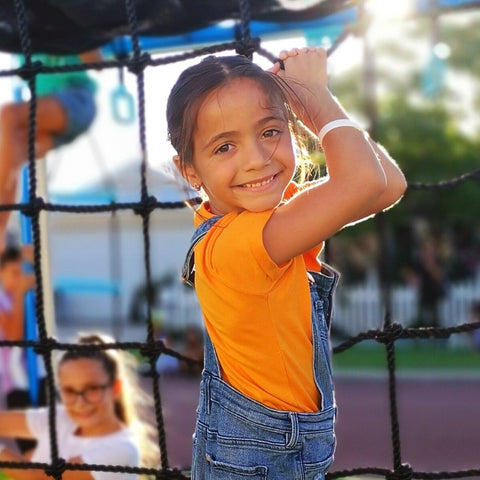Monkey bars and crossing the midline
Crossing the midline is essential for child development; physically, emotionally and intellectually. In various fields related to early childhood and child development, it is flagged as a key factor, but it’s not something that we - as parents - necessarily know very much about.
So what is the midline? How do you cross it? And why is it so important to do so?

Imagine a line down the centre of your child’s body from their head to their feet. This is their midline. Not only does it bisect their body, but also their brain – with the left hemisphere on one side and the right on the other. These hemispheres are joined by the corpus callosum; a thick bundle of nerve fibres which allow communication between the two halves.
This communication is vital for the development of complex language skills in children and allows young brains to access and strengthen new thinking. It also plays a part in your child’s hand-eye coordination and the development of fine and gross motor skills.
In order to cross this midline we must move one arm or leg across the middle of our bodies, to the other side, to perform a particular task. You may notice that young babies will reach for an object that is on their left side with their left hand, and the same on their right side.
It isn’t until around six months of age that they might reach across their body with a hand, or transfer objects from one hand to another. This is a developmental milestone and one of the first examples of crossing the midline.

As children grow they should be engaging in activities which promote crossing the midline on a daily basis. This increases the ability for information being processed on one side of the brain to be shared with the other side. There are many movement-based activities which include crossing the midline.
As babies, rolling over and crawling are both big milestones and both involve crossing the baby’s midline. Try combining that all important tummy time with opportunities to reach out and across, and grasp toys which can be arranged in an arc in front of them.

With older children, opportunities for moving their bodies can come from participating in sports; throwing, kicking and catching balls, working on gymnastics moves or dancing around to music. It can also occur in the form of free play; climbing trees, chasing after and popping bubbles, or using monkey bars and other playground equipment. With each hand-over-hand swing your child performs on monkey bars, monkey rings or ninja grips, they are reinforcing that connection between the right and left side of the brain.
Essentially the more freedom of movement a child is allowed, the more they will naturally develop their skills in crossing the midline and in turn, the more their brain will make those all-important neural pathways.




